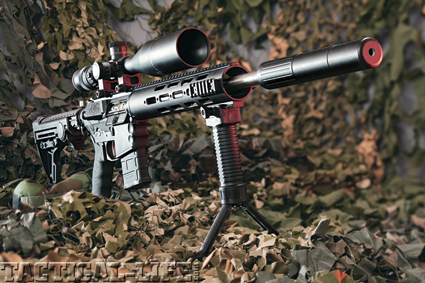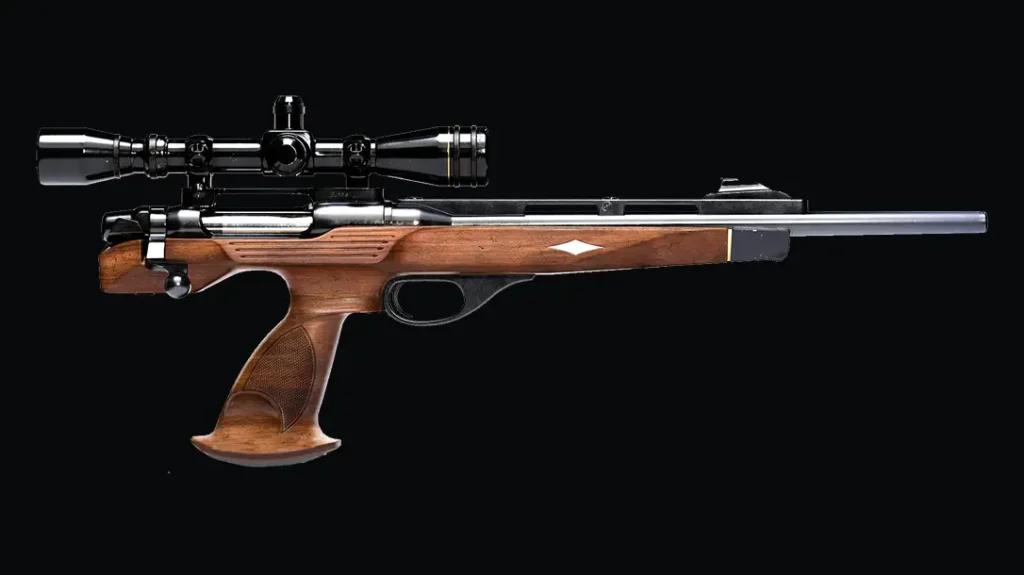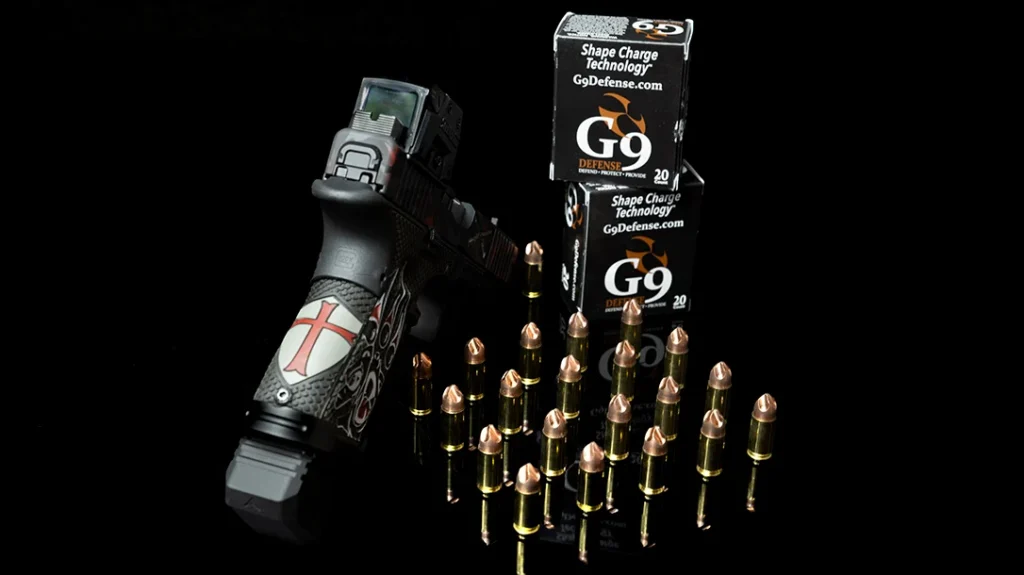During load development, the Loki Weapons System Patrol Rifle in 300 Blackout was able wring out sub-MOA accuracy. Shown here with a Trijicon 5-20x50mm riflescope and Grip Pod.
At industry trade shows, manufacturers normally secure a local firing range and invite several gun writers as they show off their new wares. At one of these events back in the early 1990s out in Las Vegas, I had a rental car and drove to the range instead of catching a shuttle bus. Through a chance encounter, I met J.D. Jones in the hotel lobby and he asked for a ride. What neophyte gun writer wouldn’t chauffeur such a “rock star” legend of the firearms world? J.D. told me about several projects he had just completed for military applications. One of them was the .300 Whisper. This new wildcat, (the name owned by Jones), used a resized .221 Fireball case necked up to .30 caliber, which fired 200- to 240-grain Sierra Match Kings at subsonic velocities. That was my first introduction to this fascinating cartridge.
Recently, I learned that the U.S. military began working on a round very similar to the .300 Whisper at USAF Armament Lab at Eglin Air Force Base in the late 1960s. The military produced the 7.62×28 cartridge, which propelled a 172-grain match projectile to the 1,050 feet per second (fps) range.
Advertisement — Continue Reading Below
Several years later, an old friend, Gary Cook, introduced me to the .300 Whisper’s twin brother, the .300/221 Fireball. Cook was the Tennessee Wildlife Resources Agency’s top cop in charge of wildlife management for West Tennessee. Each summer, hundreds of whitetails were to be killed by biologists to collect herd health data that was used to set harvest regulations for the following season. Since much of this deer collection was conducted at night, after several years of officers shooting high-powered rifles after dark, the poacher hotline kept getting flooded with calls. So the solution Cook chose was to arm his officers with suppressed Savage bolt-actions re-chambered in 300/.221 Fireball.
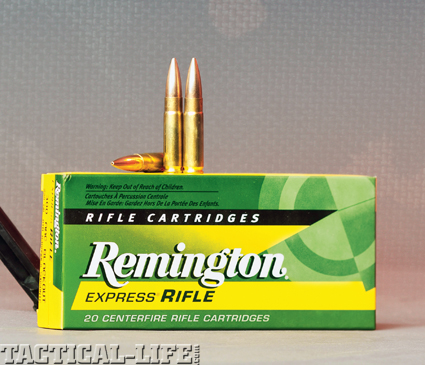
By the end of the year there should be about 25 different 300 BLK loads on the market. Bullet and powder companies are working on load development. This could be the .40 S&W of the rifle world.
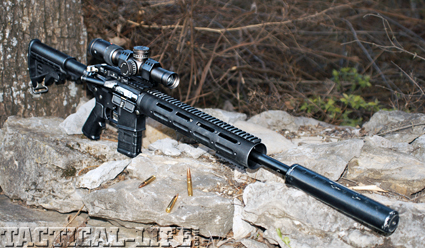
The Delta Company Arms 300 Blackout upper was mated with a Stag Arms lower receiver fitted with a Timney trigger, and topped with a Vortex 1-4x optic. JAY LANGSTON PHOTO
Advertisement — Continue Reading Below
300 Blackout Arrives
The 300 Blackout system was developed by AAC and Remington to launch .30 caliber projectiles from the AR platform without reduction in magazine capacity while remaining compatible with the AR-15 standard bolt. Remington received Sporting Arms and Ammunition Manufacturers Institute (SAAMI) acceptance of new cartridge in January 2011. AAC officially designated it as the 300 AAC Blackout, or the 300 BLK. The metric designation is 7.62x35mm.
With subsonic cartridges, the 300 BLK produces a low sound signature when suppressed, and the development of 123-grain full-speed ammunition matches the ballistics of the 7.62x39mm AK. In fact, from a 9-inch barrel, the 300 BLK produces more muzzle energy than a 5.56mm M855 round from a 16-inch barrel.
The first priority of the 300 BLK was to utilize the existing inventory of 5.56mm NATO magazines while retaining their full capacity. Next, AAC wanted to create the optimal platform for sound- and flash-suppressed fire. Another objective was to create compatible supersonic ammo that matches 7.62x39mm ballistics. The 300 BLK also provides the ability to penetrate barriers with high-mass projectiles. Providing all of these capabilities in a lightweight, durable, low-recoiling package wrapped up the project’s objectives.
Advertisement — Continue Reading Below
The 7.62x39mm was eliminated from consideration as a possible chambering because of extreme cartridge taper. The taper of the 7.62x39mm cartridge reduces reliability of feeding in AR magazines, and lowers magazine capacity. Another inherent weakness is that it increases an AR bolt’s weaknesses by yielding higher bolt thrust. Making matters worse, the bolt face must be opened up to fit a 7.62x39mm cartridge head, which leads to less bolt locking lug strength. Limited projectile availability for the 7.62x39mm’s .311 bullet diameter was another factor in its rejection from the project.
A standard M4 bolt is used for the new cartridge, and it matches or exceeds M4 endurance and durability. Compared with 5.56, a 7.62×39 or a 6.8 SPC, the BLK has reduced muzzle flash and “gasses” the shooter less. When fired from a 9-inch barrel, the 300 BLK produces more devastating terminal effect than a 5.56mm, and on par with the 7.62x39mm or 6.8 SPC. Summing it up, the pioneering work by J.D. Jones with the .300 Whisper, and others with .300 Fireball, proved AAC’s weapons platform concept.
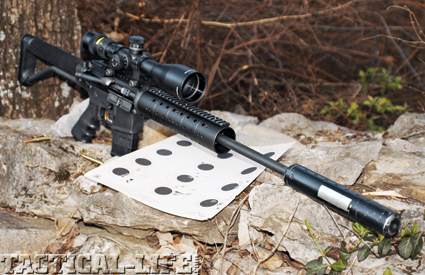
AAC’s 300 Blackout barrel was tricked out with an Anderson Manufacturing upper and a Bushmaster lower fitted with an AR Gold trigger. JAY LANGSTON PHOTO
Advertisement — Continue Reading Below
Installing a suppressor on a weapon typically increases the rate of fire. When comparing a suppressed to a non-suppressed 10-inch barreled 300 BLK AR to a 10-inch 5.56mm AR, the 300 BLK is a winner. The average rate of fire for a 5.56mm increases 34%, from an average rate of fire of 737 rounds per minute (rpm) to 985 rpm when suppressed. A supersonic load in the 300 BLK increases 18%, from 821 rpm to 970 rpm. Firing subsonic 300 BLK loads only upped the rate of fire 5%, from 746 rpm to 780 rpm.
Additional testing by AAC revealed that the 300 BLK has a point-of-impact shift with and without a suppressor of 1.3 MOA at 100 meters supersonic, and 2.4 MOA subsonic. On the endurance side of the equation, the mean number of rounds between stoppage was 738 rounds for the 5.56mm, and 640 rounds for the 300 BLK. Barrel life for a 5.56mm is typically about 9,000 rounds, whereas the 300 BLK has reached 30,000 rounds and climbing, as the testing is ongoing.
When comparing a 9-inch 300 BLK M4 PDW to an MP5-SD3, it really excels. The MP5 weighs 7.9 pounds, and the 300 BLK PDW weighs 7.0 pounds when configured with a CTR stock, an H2 buffer and an AAC 762 SDN-6 suppressor with no magazine or sights. The compact length for the MP5 is 26.4 inches, and 31.7 inches with stock extended. An M4 with stock collapsed and no can measures 25.75 inches, and 34.25 inches with a CTR stock extended and suppressor attached. Firepower is where the 300 BLK really excels. The MP5 fires a 115-grain bullet at 900 fps, whereas the 300 BLK PDW firing a 220-grain bullet at 1,000 fps produces 129% more energy at the muzzle and even more downrange.
Advertisement — Continue Reading Below
“When people want to shoot suppressed, the MP5-SD3 has become obsolete because it can’t shoot through barriers, from armor, to wall board or windshields,” said Robert Silvers, director of Research and Development at AAC. You can keep an M4 Blackout quiet, and it penetrates well. And, it makes a good home defense weapon, too. It has more energy than an M4 with a 16-inch barrel, and for people who want to hunt with their AR, it satisfies that, too. The Blackout is extremely versatile and can handle bullets from 110 grains to 240 grains.”
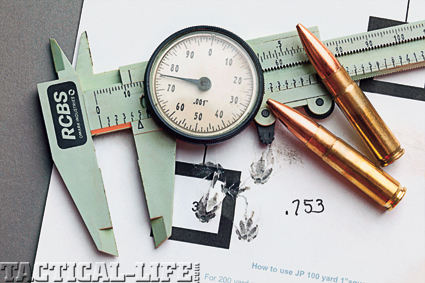
The 300 Blackout handload with a Sierra 220-grain Match King bullet produced this impressive 5-shot group of 0.753” from 100 yards.
Shooting Impressions
When I asked Silvers about the longer throat in the 300 BLK he said, “The people that don’t like the longer throat seem to always bring that up. We get good results from a test barrel. We shot ten, 5-round groups that came in under 0.85 of an inch.”
Advertisement — Continue Reading Below
The 300 Blackout is a short-range round. When it is zeroed at 100 yards the 300 Blackout—loaded with a sub-sonic 220-grain Sierra Match King—drops nearly three feet when it passes the 200-yard mark. The same zero with a 125-grain Nosler Ballistic Tip bullet traveling at 2,200 fps will drop approximately 7.3 inches at 200 yards.
The basic difference between the 300 BLK chamber and the .300 Whisper or .300 Fireball is the length of the throat. The 300 BLK is slightly longer. One of the quirks of the .300 Whisper is the variation in brass thickness among the many makes of 5.56mm ammunition. The 300 BLK’s longer throat mitigates the issue.
My initial loads were educated guesses to determine velocities. Serious accuracy loading would come later. Cases were primed with either CCI 400, Federal Small Rifle Benchrest, or Winchester Small Rifle primers. I loaded H110, Accurate 1680, or Reloader No. 7 powder for initial testing. An AAC .30 caliber Cyclone suppressor was used for all testing.
Advertisement — Continue Reading Below
To learn more about the 300 BLK, I tested three AR different platforms. I got in touch with AAC and received one of the first barrels available, along with a low-profile carbine-length gas block and gas tube. To build a complete upper receiver, I had Anderson Manufacturing, mate the AAC barrel with one of their upper receivers and handguards.
AAC’s 300 Blackout AR-15 barrels are 4159 chrome moly vanadium steel with a 1-in-8-inch twist. They utilize a standard M4 barrel extension, and have a high-reliability self-loading specific chamber. The chamber dimensions are slightly larger than found on bolt guns to increase reliability. Their barrels are treated with proprietary nitride surface treatment on the barrel and extension assembly to give up to a 60 longer barrel life than chrome plating the barrel. The treatment improves corrosion resistance, reduces friction, and improves accuracy issues, like hard chroming the barrel and creating coating thickness variations. The muzzle is threaded 5/8×24 tpi (threads per inch) and comes with a thread protector.
Range Time
At the range, I attached the AAC/Anderson Manufacturing upper to a Bushmaster lower with an AR Gold trigger, and was ready to send rounds down range. Using a Leupold 8-20x Mark 4 scope, I was able to shoot several 5-shot subsonic 100-yard groups. The average for 12 groups fired was a hair under 2 inches, with two groups measuring sub MOA. Hornady’s 208-grain AMax, Sierra’s 210- and 220-grain Match Kings and Berger’s 210-grain VLD all hold promise as load tuning continues.
Advertisement — Continue Reading Below
The next upper receiver in 300 BLK came from Delta Company Arms, which is comprised of their upper, a Samson forend, a Young Manufacturing National Match bolt carrier assembly and an adjustable pistol-length gas block. This one was mated with a Stag Arms lower with a Timney trigger. This rig performed in like manner, with some groups approaching 2 MOA and a few sub-MOA.
The third weapon was a Loki Weapons System Patrol Rifle. In short, this rig is comprised of Loki’s billet upper and lower, an Ergo F93 Pro adjustable stock and Loki’s forend and adjustable gas block set at the carbine position on a 16-inch Satern barrel. I fired a hodge-podge of reloads trying to find the performers, just as I had done with the two other rigs. I even tried two CorBon .300 Whisper factory loads. No matter what I threw at it, this rig performed well, too. The average of all 5-shot groups measured 1.7 MOA. I shot one 0.75 of an inch group with a 220-grain Sierra Match King on top of 10.8 grains of A1680. CorBon’s 220-grain SMK subsonic load also shot a 0.78 of an inch group. CorBon’s 125-grain .300 Whisper load averaged less that MOA, with the smallest measuring 0.81 of an inch.
Since I have evidence that all three of these setups can shoot sub-MOA, it’s up to me to narrow down their individual preference in handloads.
Final Notes
“By the end of the year, there should be about 25 different loads on the market,” according to Silvers. “Bullet and powder companies are working on load development. This could be the 40 S&W of the rifle world.” Although I’ve always enjoyed shooting the .300 Whisper, or the .300 Fireball, the new 300 BLK designation is sure to shine some new light on this interesting cartridge. It certainly has some valid military and law enforcement applications, and should garner significant consumer acceptance.
Take a look at this article: How to Roll Your Own 300 Blackout Ammo for Cheaper Stealth Shooting
